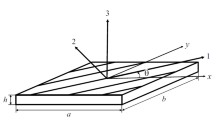Abstract
A new discrete Kirchhoff quadrilateral element based on the refined third-order theory is developed for the analysis of composite plates. The element has seven degrees of freedom per node, namely, the three displacements, two rotations and two transverse shear strain components at the mid-surface. The inplane displacements and the shear strains are interpolated using bilinear interpolation functions and the mid-surface rotations are interpolated using bi-quadratic functions based on the discrete Kirchhoff technique. The element stiffness matrix and the consistent load vector are developed using the principle of virtual work. The finite element formulation is validated by comparing the results for simply-supported plate with the analytical Navier solution. Comparison of the present results with those using other available elements based on the TOT establishes the superiority of the present element in respect of simplicity, accuracy and computational efficiency. The element is free from shear locking
Similar content being viewed by others
References
Batoz JL, Tahar MB (1982) Evaluation of a new quadrilateral thin plate bending element. Int J Numer Meth Eng 18:1655–1677
Ghosh AK, Dey SS (1992) A simple finite element for the analysis of laminated plates. Comput Struct 44(3):585–596
Haldar S (2001) Static and dynamic analysis of composite plates, shells and folded plates using a high precision shallow shell element. Ph.D. Thesis, Department of Applied Mechanics, Bengal Engineering college (deemed University), India
Hinton E, Huang HC (1986) A family of quadrilateral Mindlin plate elements with substitute shear strain fields. Comput Struct 23(3):409–431
Hughes JR, Cohen M, Haroun M (1978) Reduced and selective integration techniques in the finite element analysis of plates. Nucl Eng Des 46(1):203–222
Pai PF (1995) A new look at shear correction factors and warping functions of anisotropic laminates. Int J Solids Struct 32:2295–2313
Phan ND, Reddy JN (1985) Analysis of laminated composite plates using a higher order shear deformation theory. Int J Numer Meth Eng 21:2201–2219
Prathap G, Somashekar BR (1988) Field-and edge-consistency synthesis of a 4-noded quadrilateral plate bending element. Int J Numer Meth Eng 26:1693–1708
Putcha NS, Reddy JN (1986) A refined mixed shear flexible finite element for the nonlinear analysis of laminated plates. Comput Struct 22(4):529–538
Reddy JN (1984) A simple higher order theory for laminated composite plates. J Appl Mech Trans ASME 51:745–752
Reddy JN (1989) On refined computational models of composite laminates. Int J Numer Meth Eng 27:361–382
Ren JG, Hinton E (1986) The finite element analysis of homogeneous and laminated composite plates using a simple higher order theory. Commun Appl Numer Meth 2:217–228
Sheikh AH, Chakrabarti A (2003) A new plate bending element based on higher order shear deformation theory for the analysis of composite plates. Finite Elem Anal Des 39:883–903
Whitney JM, Pagano NJ (1970) Shear deformation in heterogeneous anisotropic plates. J Appl Mech Trans ASME 37:1031–1036
Zienkiewicz OC, Cheung YK (1964) The finite element method for the analysis of elastic, isotropic and orthotropic slabs. Proc Inst Civil Eng 28:471–488
Author information
Authors and Affiliations
Corresponding author
Rights and permissions
About this article
Cite this article
Kulkarni, S.D., Kapuria, S. A new discrete Kirchhoff quadrilateral element based on the third-order theory for composite plates. Comput Mech 39, 237–246 (2007). https://doi.org/10.1007/s00466-005-0020-y
Received:
Accepted:
Published:
Issue Date:
DOI: https://doi.org/10.1007/s00466-005-0020-y




